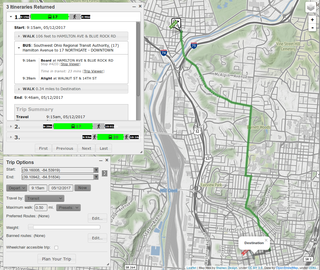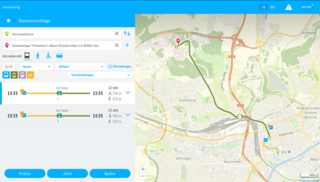
The Open Systems Interconnection model is a conceptual model from the International Organization for Standardization (ISO) that "provides a common basis for the coordination of standards development for the purpose of systems interconnection." In the OSI reference model, the communications between systems are split into seven different abstraction layers: Physical, Data Link, Network, Transport, Session, Presentation, and Application.
A standard data model or industry standard data model (ISDM) is a data model that is widely applied in some industry, and shared amongst competitors to some degree. They are often defined by standards bodies, database vendors or operating system vendors.

A bus stop is a place where buses stop for passengers to get on and off the bus. The construction of bus stops tends to reflect the level of usage, where stops at busy locations may have shelters, seating, and possibly electronic passenger information systems; less busy stops may use a simple pole and flag to mark the location. Bus stops are, in some locations, clustered together into transport hubs allowing interchange between routes from nearby stops and with other public transport modes to maximise convenience.
Universal Business Language (UBL) is an open library of standard electronic XML business documents for procurement and transportation such as purchase orders, invoices, transport logistics and waybills. UBL was developed by an OASIS Technical Committee with participation from a variety of industry data standards organizations. UBL is designed to plug directly into existing business, legal, auditing, and records management practices. It is designed to eliminate the re-keying of data in existing fax- and paper-based business correspondence and provide an entry point into electronic commerce for small and medium-sized businesses.

The National Public Transport Access Node (NaPTAN) database is a UK nationwide system for uniquely identifying all the points of access to public transport in the UK. The dataset is closely associated with the National Public Transport Gazetteer.

The Transport Direct Programme was a division of the UK Department for Transport (DfT) to develop standards, data and better information technology systems to support public transport. It developed and operates the Transport Direct Portal which is a public facing multi-modal journey planner. It also supports the creation and management of comprehensive databases of all public transport movements in the United Kingdom with Traveline. During 2010 two key datasets were released as Open Data and published on www.data.gov.uk.

A passenger information system, or passenger information display system, is an automated system for supplying users of public transport with information about the nature and the state of a public transport service through visual, voice or other media. It is also known as a customer information system or an operational information system. Among the information provided by such systems, a distinction can be drawn between:
The European Committee for Standardization (CEN) Standard Architecture for Healthcare Information Systems, Health Informatics Service Architecture or HISA is a standard that provides guidance on the development of modular open information technology (IT) systems in the healthcare sector. Broadly, architecture standards outline frameworks which can be used in the development of consistent, coherent applications, databases and workstations. This is done through the definition of hardware and software construction requirements and outlining of protocols for communications. The HISA standard provides a formal standard for a service-oriented architecture (SOA), specific for the requirements of health services, based on the principles of Open Distributed Processing. The HISA standard evolved from previous work on healthcare information systems architecture commenced by Reseau d’Information et de Communication Hospitalier Europeen (RICHE) in 1989, and subsequently built upon by a number of organizations across Europe.
The ISO/TC 215 is the International Organization for Standardization's (ISO) Technical Committee (TC) on health informatics. TC 215 works on the standardization of Health Information and Communications Technology (ICT), to allow for compatibility and interoperability between independent systems.
CEN ISO/IEEE 11073 Health informatics - Medical / health device communication standards enable communication between medical, health care and wellness devices and external computer systems. They provide automatic and detailed electronic data capture of client-related and vital signs information, and of device operational data.
Transport standards organisations is an article transport Standards organisations, consortia and groups that are involved in producing and maintaining standards that are relevant to the global transport technology, transport journey planning and transport ticket/retailing industry. Transport systems are inherently distributed systems with complex information requirements. Robust modern standards for transport data are important for the safe and efficient operation of transport systems. These include:
TransXChange is a UK national XML based data standard for the interchange of bus route and timetable information between bus operators, the Vehicle and Operator Services Agency, local authorities and passenger transport executives, and others involved in the provision of passenger information.
The Standard Interface for Real-time Information or SIRI is an XML protocol to allow distributed computers to exchange real-time information about public transport services and vehicles.
IFOPT is a CEN Technical Specification that provides a Reference Data Model for describing the main fixed objects required for public access to Public transport, that is to say Transportation hubs. Such a model is a fundamental component of the modern Public transport information systems needed both to operate Public transport and to inform passengers about services.

A journey planner, trip planner, or route planner is a specialized search engine used to find an optimal means of travelling between two or more given locations, sometimes using more than one transport mode. Searches may be optimized on different criteria, for example fastest, shortest, fewest changes, cheapest. They may be constrained, for example, to leave or arrive at a certain time, to avoid certain waypoints, etc. A single journey may use a sequence of several modes of transport, meaning the system may know about public transport services as well as transport networks for private transportation. Trip planning or journey planning is sometimes distinguished from route planning, which is typically thought of as using private modes of transportation such as cycling, driving, or walking, normally using a single mode at a time. Trip or journey planning, in contrast, would make use of at least one public transport mode which operates according to published schedules; given that public transport services only depart at specific times, an algorithm must therefore not only find a path to a destination, but seek to optimize it so as to minimize the waiting time incurred for each leg. In European Standards such as Transmodel, trip planning is used specifically to describe the planning of a route for a passenger, to avoid confusion with the completely separate process of planning the operational journeys to be made by public transport vehicles on which such trips are made.

GTFS, which stands for General Transit Feed Specification or (originally) Google Transit Feed Specification, defines a common format for public transportation schedules and associated geographic information. GTFS contains only static or scheduled information about public transport services, and is sometimes known as GTFS Static or GTFS Schedule to distinguish it from the GTFS Realtime extension, which defines how information on the realtime status of services can be shared.
The system of concepts to support continuity of care, often referred to as ContSys, is an ISO and CEN standard . Continuity of care is an organisational principle that represents an important aspect of quality and safety in health care. Semantic interoperability is a basic requirement for continuity of care. Concepts that are needed for these purposes must represent both the content and context of the health care services.
NeTEx is the CEN Technical standard for exchanging Public Transport Information as XML documents. It provides a W3C XML schema based on the Transmodel abstract model of common public transport concepts and data structures and can be used to exchange many different kinds of data between passenger information systems, including data describing for stops, facilities, timetabling and fares. Such data can be used by both operational management systems and customer facing systems for journey planning etc.
Datex II or Datex2 is a data exchange standard for exchanging traffic information between traffic management centres, traffic service providers, traffic operators and media partners. It contains for example traffic incidents, current road works and other special traffic-related events. These data is presented in XML-format and is modeled with UML. The standard is developed by the technical body Intelligent transport systems of the European Committee for Standardization.
Clinical data standards are used to store and communicate information related to healthcare so that its meaning is unambiguous. They are used in clinical practice, in activity analysis and finding, and in research and development.






